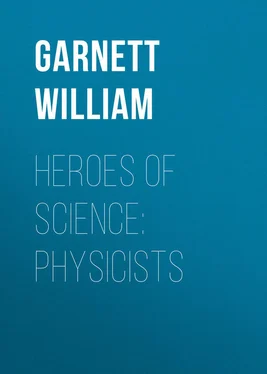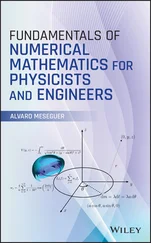William Garnett - Heroes of Science - Physicists
Здесь есть возможность читать онлайн «William Garnett - Heroes of Science - Physicists» — ознакомительный отрывок электронной книги совершенно бесплатно, а после прочтения отрывка купить полную версию. В некоторых случаях можно слушать аудио, скачать через торрент в формате fb2 и присутствует краткое содержание. Жанр: foreign_antique, foreign_prose, на английском языке. Описание произведения, (предисловие) а так же отзывы посетителей доступны на портале библиотеки ЛибКат.
- Название:Heroes of Science: Physicists
- Автор:
- Жанр:
- Год:неизвестен
- ISBN:нет данных
- Рейтинг книги:5 / 5. Голосов: 1
-
Избранное:Добавить в избранное
- Отзывы:
-
Ваша оценка:
- 100
- 1
- 2
- 3
- 4
- 5
Heroes of Science: Physicists: краткое содержание, описание и аннотация
Предлагаем к чтению аннотацию, описание, краткое содержание или предисловие (зависит от того, что написал сам автор книги «Heroes of Science: Physicists»). Если вы не нашли необходимую информацию о книге — напишите в комментариях, мы постараемся отыскать её.
Heroes of Science: Physicists — читать онлайн ознакомительный отрывок
Ниже представлен текст книги, разбитый по страницам. Система сохранения места последней прочитанной страницы, позволяет с удобством читать онлайн бесплатно книгу «Heroes of Science: Physicists», без необходимости каждый раз заново искать на чём Вы остановились. Поставьте закладку, и сможете в любой момент перейти на страницу, на которой закончили чтение.
Интервал:
Закладка:
We must now give a short account of Franklin's contributions to electrical science.
"The first is the wonderful effect of pointed bodies, both in drawing off and throwing off the electrical fire."
It will be observed that this statement is made in the language of the one -fluid theory, of which Franklin may be regarded as the author. This theory will be again referred to presently. Franklin electrified a cannon-ball so that it repelled a cork. On bringing near it the point of a bodkin, the repulsion disappeared. A blunt body had to be brought near enough for a spark to pass in order to produce the same effect. "To prove that the electrical fire is drawn off by the point, if you take the blade of the bodkin out of the wooden handle, and fix it in a stick of sealing-wax, and then present it at the distance aforesaid, or if you bring it very near, no such effect follows; but sliding one finger along the wax till you touch the blade, and the ball flies to the shot immediately. If you present the point in the dark, you will see, sometimes at a foot distance or more, a light gather upon it like that of a fire-fly or glow-worm; the less sharp the point, the nearer you must bring it to observe the light; and at whatever distance you see the light, you may draw off the electrical fire, and destroy the repelling."
By laying a needle upon the shot, Franklin showed "that points will throw off as well as draw off the electrical fire." A candle-flame was found to be equally efficient with a sharp point in drawing off the electricity from a charged conductor. The effect of the candle-flame Franklin accounted for by supposing the particles separated from the candle to be first "attracted and then repelled, carrying off the electric matter with them." The effect of points is a direct consequence of the law of electrical repulsion. When a conductor is electrified, the density of the electricity is greatest where the curvature is greatest. Thus, if a number of spheres are electrified from the same source, the density of the electricity on the different spheres will vary inversely as their diameters. The force tending to drive the electricity off a conductor is everywhere proportional to the density, and hence in the case of the spheres will be greatest for the smallest sphere. On this principle, the density of electricity on a perfectly sharp point, if such could exist, on a charged conductor, would be infinite and the force tending to drive it off would be infinite also. Hence a moderately sharp point is sufficient to dissipate the electricity from a highly charged conductor, or to neutralize it if the point is connected to earth and brought near the conductor so as to be electrified by induction.
Franklin next found that, if the person rubbing the electric tube stood upon a cake of resin, and the person taking the charge from the tube stood also on an insulating stand, a stronger spark would pass between these two persons than between either of them and the earth; that, after the spark had passed, neither person was electrified, though each had appeared electrified before. These experiments suggested the idea of positive and negative electrification; and Franklin, regarding the electric fluid as corresponding to positive electrification, remarked that "you may circulate it as Mr. Watson has shown; you may also accumulate or subtract it upon or from any body, as you connect that body with the rubber or with the receiver, the common stock being cut off." Thus Franklin regarded electricity as a fluid, of which everything in its normal state possesses a certain amount; that, by appropriate means, some of the fluid may be removed from one body and given to another. The former is then electrified negatively, the latter positively, and all processes by which bodies are electrified consist in the removal of electricity from one body or system and giving it to another. He regarded the electric fluid as repelling itself and attracting matter. Æpinus afterwards added the supposition that matter, when devoid of electricity, is self-repulsive, and thus completed the "one-fluid theory," and accounted for the repulsion observed between negatively electrified bodies.
It had been usual to employ water for the interior armatures of Leyden jars, or phials, as they were then generally called. Franklin substituted granulated lead for the water, thereby improving the insulation by keeping the glass dry. With these phials he contrived many ingenious experiments, and imitated lightning by discharging them through the gilding of a mirror or the gold lines on the cover of a book. He found that the inner and outer armatures of his Leyden jars were oppositely electrified. "Here we have a bottle containing at the same time a plenum of electrical fire and a vacuum of the same fire; and yet the equilibrium cannot be restored between them but by a communication without ! though the plenum presses violently to expand, and the hungry vacuum seems to attract as violently in order to be filled." The charging of Leyden jars by cascade, that is by insulating all the jars except the last, connecting the outer armature of the first with the inner armature of the second, and so on throughout the series, was well understood by Franklin, and he knew too that by this method the extent to which each jar could be charged from a given source varied inversely as the number of jars. The discharge of the Leyden jar by alternate contacts was also carried out by him; and he found that, if the jar is first placed on an insulating stand, it may be held by the hook (or knob) without discharging it. Franklin, in fact, appears to have known almost as much about the Leyden jar as is known to-day. He found that, when the armatures were removed from a jar, no discharge would pass between them, but when a fresh pair of armatures were supplied to the glass, the jar could be discharged. "We are of opinion that there is really no more electrical fire in the phial after what is called its charging than before, nor less after its discharging ; excepting only the small spark that might be given to and taken from the non-electric matter, if separated from the bottle, which spark may not be equal to a five-hundredth part of what is called the explosion.
"The phial will not suffer what is called a charging unless as much fire can go out of it one way as is thrown in by another.
"When a bottle is charged in the common way, its inside and outside surfaces stand ready, the one to give fire by the hook, the other to receive it by the coating; the one is full and ready to throw out, the other empty and extremely hungry; yet, as the first will not give out unless the other can at the same time receive in , so neither will the latter receive in unless the first can at the same time give out. When both can be done at once, it is done with inconceivable quickness and violence."
Then follows a very beautiful illustration of the condition of the glass in the Leyden jar.
"So a straight spring (though the comparison does not agree in every particular), when forcibly bent, must, to restore itself, contract that side which in the bending was extended, and extend that which was contracted; if either of these two operations be hindered, the other cannot be done.
"Glass, in like manner, has, within its substance, always the same quantity of electrical fire, and that a very great quantity in proportion to the mass of the glass, as shall be shown hereafter.
"This quantity proportioned to the glass it strongly and obstinately retains, and will have neither more nor less, though it will suffer a change to be made in its parts and situation; i. e. we may take away part of it from one of the sides, provided we throw an equal quantity into the other."
Читать дальшеИнтервал:
Закладка:
Похожие книги на «Heroes of Science: Physicists»
Представляем Вашему вниманию похожие книги на «Heroes of Science: Physicists» списком для выбора. Мы отобрали схожую по названию и смыслу литературу в надежде предоставить читателям больше вариантов отыскать новые, интересные, ещё непрочитанные произведения.
Обсуждение, отзывы о книге «Heroes of Science: Physicists» и просто собственные мнения читателей. Оставьте ваши комментарии, напишите, что Вы думаете о произведении, его смысле или главных героях. Укажите что конкретно понравилось, а что нет, и почему Вы так считаете.












